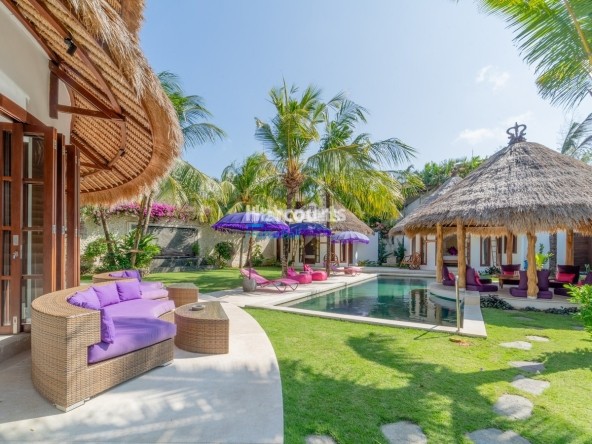A Komodo dragon appears to face off against a pair of construction workers in a photo that caused concern after going viral in 2020. (instagram /instagram@gregoriusafioma )
A. Muh. Ibnu Aqil (The Jakarta Post)
Jakarta ● Sat, August 7, 2021
The ongoing infrastructure development in Komodo National Park, East Nusa Tenggara, have come into the spotlight after the United Nations Educational, Scientific and Cultural Organization (UNESCO) urged the government to halt the project.
During its virtual meeting last month, UNESCO’s World Heritage Committee, which has the authority to determine World Heritage status for sites, outlined its concerns over the planned development of the national park, which the committee warned could threaten the park’s outstanding universal value (OUV).
The OUV is one of the main criteria used by the committee to determine whether a site should be accorded UNESCO World Heritage status. The Komodo National Park has been included in UNESCO’s World Heritage list since 1991.
In one of the reports produced after the meeting, the committee urged the government to halt all tourism infrastructure projects in and around the national park, particularly those that have the potential to affect the park’s OUV, until the government has submitted a revised environmental impact assessment (EIA) to be reviewed by the International Union for Conservation of Nature.
“It is of concern that the EIA for the tourism infrastructure projects on Rinca Island did not adequately assess potential impacts on the property’s OUV,” the report reads.
Rinca Island is one of three major islands within Komodo National Park, along with Komodo Island and Padar Island.
In the report, the committee also asked the government to submit detailed information in its plan to ensure that the Komodo National Park’s OUV will be safeguarded along with the revised EIA.
The World Heritage Committee’s concerns have raised further questions over the government’s plan to turn Komodo National Park and the neighboring city of Labuan Bajo, which is located outside the national park, into one of its premium tourism destinations as outlined in the latter’s Integrated Tourism Master Plan (ITMP).
The government’s tourism plan for the national park began to receive attention last year after a viral photo on social media showed a Komodo dragon appearing to face off against a pair of construction workers, sparking alarm that infrastructure development in the area would come at the cost of endangering the dragon’s habitat.
The Environment and Forestry Ministry’s director general for natural resources and ecosystems, Wiratno, said the government acknowledged the UNESCO request to halt the projects, but added that the current plan would proceed given that the projects were already nearing completion.
“It’s not right for UNESCO to halt a sovereign nation’s projects, given that there is little [environmental] impact from it,” Wiratno told The Jakarta Post on Thursday, adding that the infrastructure projects on Rinca Island only involved previously existing buildings.
Tourism and Creative Economy Minister Sandiaga Uno said that the government would prioritize principles of sustainable tourism in developing the super priority destinations such as Komodo National Park and Labuan Bajo.
“In practice, principles of sustainable tourism include community empowerment through [preserving] local cultures, along with protecting nature to improve the prosperity [of the local community],” Sandiaga said in a written statement on Thursday.
“[We] are not only calculating the economic impacts [of the projects], but also the impacts on the local environment and cultural and social landscape of the locals,” he added.
He also said that the ministry was cooperating with various stakeholders to make sure that the tourism infrastructure within Komodo National Park would have no negative impact on the site’s OUV.
The development on Rinca Island will cost around Rp 69.69 billion (US$4.86 million), a small proportion of the total Rp 902.47 billion that the Public Works and Housing Ministry has allocated to develop Labuan Bajo and Komodo National Park as a strategic national tourism area.
NGO Sunspirit for Justice and Peace researcher Venan Haryanto said that UNESCO’s warning had arrived rather late as the government had already made a comprehensive plan for the national park and Labuan Bajo, but added that he hoped that UNESCO’s warning would be “taken seriously” by the government.
Indonesian Center for Environment Law (ICEL) researcher Grita Anindarini said that the government should have properly communicated its plans and the EIA documents for projects inside Komodo National Park, given its status as a World Heritage site.
The infrastructure projects in Komodo National Park have reportedly been exempted from the usual Environmental Impact Analysis (Amdal) requirements and instead must meet the less comprehensive standards of the Environmental Management and Environmental Monitoring (UKL-UPL) documents.
Grita said that the UKL-UPL documents were less comprehensive than an Amdal as they did not discuss the impact of infrastructure projects on the Komodo National Park OUV.
“The impact on the OUV is not only on the [endemic] Komodo dragon, but also on the coral reefs, savannah and beaches of the national park as a World Heritage site,” Grita said.
She also warned of the possibility that Komodo National Park could be delisted from its World Heritage status by UNESCO if the government failed to address the UN body’s concerns, pointing to the recent delisting of Liverpool’s waterfront in the United Kingdom from its World Heritage status due to infrastructure developments in the area.





